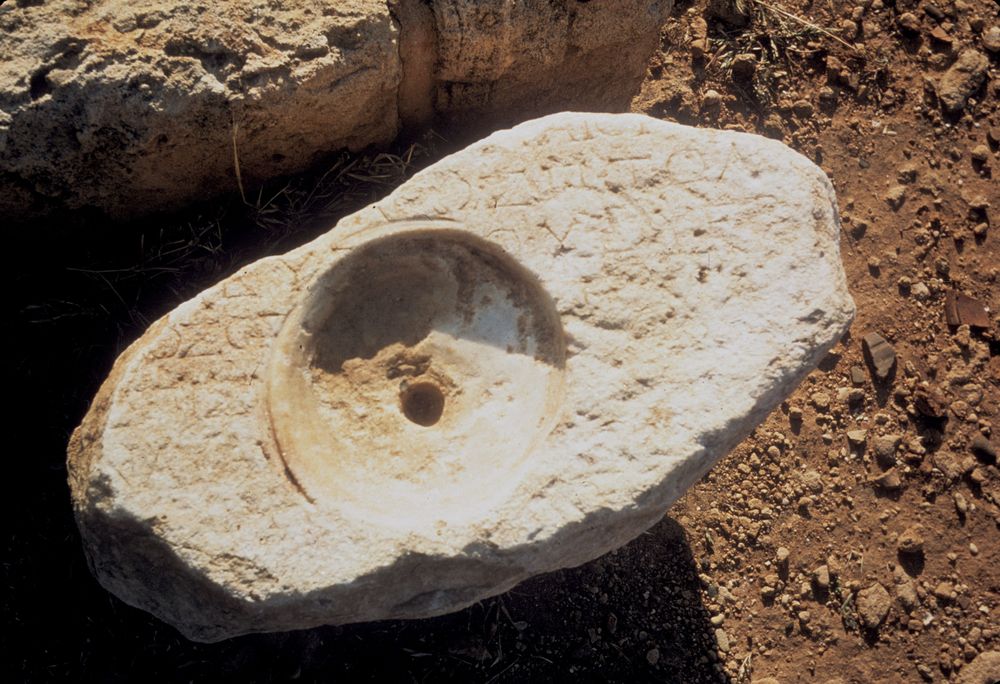EpiDoc XML:
IGCyr1025002
Trismegistos ID:
44180
Source description
Support: Fragment of a white marble base, broken off all around, (as preserved w: 0.515 × h: 0.30 × d: 0.365); re-cut later with a central hole in the inscribed face, forming a small basin (diameter 0.085).
Layout: Inscribed on front face (w: 0.455 × h: 0.28).
Letters: 0.023-0.025; small serifs, upper part of upsilon widely open, non-slanting sigma, theta with small central dot.
Date: Between 108 and 103 BC (reign, prosopography).
Findspot: Found plausibly before 1935 in the Port of Cyrene, later Apollonia ➚: in the West Church.
Place of origin: Port of Cyrene, later Apollonia ➚.
Last recorded location: Apollonia Museum, inv. number unknown. Seen by G. Pugliese Carratelli in 1960 at the same place. Seen by C. Dobias-Lalou in 1976 in the Port of Cyrene, later Apollonia ➚: outside the North-Eastern angle of West Church.. Seen again in 2004 in the Port of Cyrene, later Apollonia ➚: Apollonia Museum.
Text constituted from: Transcription from stone (CDL).
Bibliography
SECir, 204 (no image); Hauben in Hauben – Van't Dack 1971, pp. 33-34; Robert, BE, 1972.622; Bagnall 1972; Reynolds 1976, pp. 305-306, n. 24, whence SEG, 27.1126; IGCyr 102500 ➚. Cf. Mooren 1975, n. 0372; Mooren 1977, pp. 186-188; Hauben 1977; Laronde 1987, pp. 446, 462; Criscuolo 2011, p. 137, footnote 22.
Text
Apparatus
1: [Βασιλέα Πτολεμ]αῖον̣ [θεὸν Σω] Bagnall 1972: [---Πτολεμ?]αῖον̣ SECir; [Βασιλέα Πτολεμ]αῖον̣ [Σωτῆρα] Hauben – Van't Dack 1971
2: [τῆρα βασι]λέως Πτολε̣[μαίου] Bagnall 1972: [--- βασι]λέως Πτολε̣[μαίου ---] SECir; [τὸν ἐγ βασι]λέως Hauben – Van't Dack 1971
3: [τοῦ] δ̣ευτ̣[έρ]ου Εὐερ[γέτου] Hauben – Van't Dack 1971: [---]+ΕΥ+[...]ΟΥ Εὐερ[γετ] SECir
4: [Στόλ]ος Θέ[ωνος ὁ συ]γ̣γ[ενής] Hauben – Van't Dack 1971: [---]ΟΣΟ+[---]+[---] SECir
5: [καὶ] ἐ̣πίσ[τολαγράφος καὶ ἀρχεδέατρος?] Hauben – Van't Dack 1971: [---]+ΠΙΣ[---] SECir
6: [καὶ] ναύαρ̣[χος καὶ ἐπὶ τῶν ἡνίων?] Hauben – Van't Dack 1971: [---] ναυαρ̣[χ] SECir; [καὶ] ναύαρ̣[χος εὐεργεσίας] Bagnall 1972
7: [εὐερ]γ̣ε̣[σ]ί[ας ἕνεκεν τῆς εἰς ἑαυτόν] Reynolds 1976: [---]ΓΗ[---] SECir; [ἕνεκεν] τ̣ῆ[ς εἰς ἑαυτόν] Bagnall 1972
French translation
(scil. La statue du) roi Ptolémée, Dieu Sôtèr, fils du roi Ptolémée, le second Evergète, (scil. a été consacrée), par Stolos fils de Théôn, son Parent, épistolographos (i.e. secrétaire), arkhédéatros (i.e. intendant en chef), navarque, préposé aux rênes, en raison de sa bienveillance envers lui.
English translation
(scil. The statue of) king Ptolemy, God Soter, son of Ptolemy, the second Euergetes, (scil. was dedicated) by Stolos son of Theon, his Akin, epistolographos (i.e. secretary), archedeatros (i.e. chief steward), navarch, in charge of the reins, on behalf of his benevolence towards himself.
Italian translation
(scil. La statua del) re Tolemeo, Dio Sotere, figlio del re Tolemeo, Evergete secondo, (scil. è stata dedicata) da Stolos figlio di Theon, Parente, epistolographos (i.e. segretario), archedeatros (i.e. capo maggiordomo), navarco, preposto alle briglie, in considerazione della benevolenza verso di lui.
Arabic translation
(تمثال) الملك بتوليميوس (بطليموس)، المُؤلَّه المُنْقِذ، ابن الملك بتوليميوس، إفيريغيتس الثاني، (كُرِس) من قبل ستولوس بن ثيون، المُقرب منه (أوالمماثل له من حيث النفوذ والصلاحيات)، إبيستولوغرافوس (سكرتير خاص بالملك)، أرخيدياتروس (كبير الخدم أو مدير الأعمال)، نافارخوس (قائد الاسطول البحري)، والمسؤول عن زمام الأمور، لما تفضل به من خير (أي الملك) عليه أو عرفانًا بفضله.
Commentary
Pugliese Carratelli (SECir, 204) described the stone at the very place where it still laid in 1976, before being brought into the Museum for preservation. On that basis, Reynolds, who had not found it, argued that it had probably been found before 1935 and thus should have come from the Eastern Church, the only one excavated by the Italians before World War II (so again in Ward-Perkins – Goodchild – Reynolds 2003, p. 57). In fact, Pugliese Carratelli had only a copy of the stone coming from Oliverio's papers and checked the stone to complete the publication on occasion of his own visit to Cyrenaica in 1960. The date of the find is thus before 1935, but not necessarily related to real excavations. The most probable is a chance find during the Italian period in the area of the West Church. Anyhow, as the stone was re-used, maybe for a stoup, its original place cannot be guessed.
On Stolos, the Athenian admiral, see Bagnall 1972, who proposed for the Cyrenaean dedications a date between 108 and 103 BC, and Hauben 1977, who explored the possibility that he was a born Cyrenaean and later granted Athenian citizenship. Mooren 1977, pp. 187-188 explains why Stolos had the title syggenes ('Akin').
CC BY-NC-SA 4.0 Deed Attribution-NonCommercial-ShareAlike 4.0 International License.
All citation, reuse or distribution of this work must contain a link back to DOI: https://doi.org/10.60760/unibo/igcyrgvcyr2 and the filename (IGCyr000000 or GVCyr000), as well as the year of consultation.

